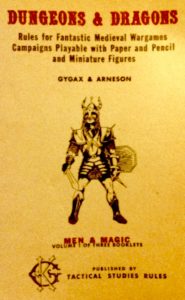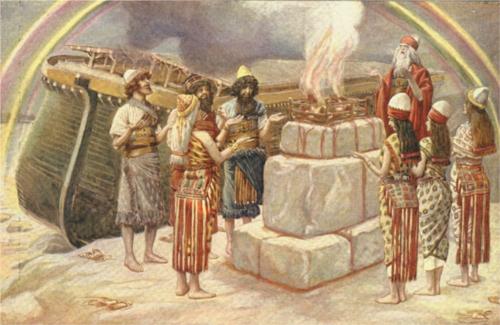In preparation for my OD&D game, I’ve been going back through the 3 LBBs to review the rules. Here is a summary of what makes up the game. Of all of the systems discussed below, only four are affected by ability scores. The social reaction mechanics are affected by charisma, the attack roll for missile weapons is affected by dexterity, and the hit die (HP) roll is affected by constitution. I have marked these with the tag [ABILITY]. Some other systems are affected by level, and I have marked them with the tag [LEVEL].
Here are the major player-facing resolution systems:
- Attack roll (d20 roll high with difficulty matrix) [ABILITY, LEVEL]
- Saving throw (d20 roll high with difficulty matrix) [LEVEL]
- 2d6 roll for turning undead (for the cleric) [LEVEL]
- Percentile roll based on investment for magical research
- Percentile skills for the thief [LEVEL]
- 1d6 damage roll
- 1d6 HP per hit die is the other side of the damage roll [ABILITY]
- 3d6 determination of ability scores
Magical research is arguably based on level, since you can only research spells of a power that you can cast, but other than that characters don’t get better at it, so I’m leaving off the tag. A roll-under ability score check is also easy to bolt on (and something I will almost certainly use), though it doesn’t show up anywhere in OD&D that I am aware of.
The referee uses all the player-facing systems, along with several others:
- 2d6 reaction roll (for social interactions) [ABILITY]
- Monster reaction: 2-5: negative, 6-8: uncertain, 9-12: positive
- Hiring monsters: 2 attack, 3-5: hostile, 6-8:uncertain, 9-11: accept, 12 enthusiast (+3 loyalty)
- 3d6 determination of retainer loyalty [ABILITY]
- Evasion/pursuit actions: too complicated to summarize
- Chance to drop something if surprised: 25%
- Random encounter: 1d6, chance by location, 1 in 6 is common
- Hear noise: 1 in 6 or 2 in 6 for demihumans
- Force doors: 2 in 6 or 1 in 6 for smaller characters
- Search: 2 in 6 or 4 in 6 for elves, which also have passive 2 in 6
- Party/monsters surprised: 2 in 6
- Trap triggers: 2 in 6
- Stronghold occupant action: 3 in 6, 2 in 6, or 1 in 6 (by hex distance)
This may look complicated, but all other than the first several they are really just 16%, 33%, or 66%. In other words: rare, uncommon, and common; or hard, medium, and easy. Talysman also has a good summary of the various d6 rolls.
There are other systems for stocking dungeons, generating treasure hoards, and populating strongholds, but they are more prep aids than game mechanics (I’m not saying that prep aids are unimportant to the game, merely that they are not required for running it). There are also subsystems for ariel and naval combat, but they are closer to separate minigames.
In the alternative combat system (which is really the standard “roll a d20” combat system), characters don’t just gain an attack bonus (or THAC0 improvement), instead they advance through a series of combat ranks (the LBBs don’t use this terminology, but it is clear from the tables). All classes begin with the same “to hit” skill (a 10 being required to hit an unarmored enemy). Fighters improve in groups of three levels, clerics and thieves in groups of four, and magic-users in groups of five. For example, magic-users of level 6 – 10 attack as fighters of level 4 – 6.
The only tables required during play are:
- Attack matrix 1: characters attacking (M&M p19)
- Attack matrix 2: monsters attacking (M&M p20)
- Saving throw matrix (M&M p22)
 These can be considered the engine of play (what might be called core mechanics in more recent games) rather than game entities which are affected by engine results. Also notable, the game is almost entirely located in Men & Magic, whereas the contents of Monsters & Treasure and The Underworld & Wilderness Adventures are more implied setting (with the exception of the mass combat minigames). And data from items one and three will probably be copied to PC character sheets, which means that the sum total of required lookup tables for 3 LBB D&D is one!
These can be considered the engine of play (what might be called core mechanics in more recent games) rather than game entities which are affected by engine results. Also notable, the game is almost entirely located in Men & Magic, whereas the contents of Monsters & Treasure and The Underworld & Wilderness Adventures are more implied setting (with the exception of the mass combat minigames). And data from items one and three will probably be copied to PC character sheets, which means that the sum total of required lookup tables for 3 LBB D&D is one!
There is clearly space here for a few more play tables, such as the Arduin critical hits table, or Jeff’s carousing table. Equipment prices, spell details, and monster stats are not strictly speaking required during play, as those are generally referenced between sessions with the relevant data being copied to character sheets or referee notes. They can be used “just in time” during play, but may be predecided, unlike the systems noted above which must be consulted during play. The following tables are on the borderline between for prep and for play; I could see occasionally wanting to consult them at the table, but most of the time they can be used offline.
- Ability score consequences (M&M p11-12)
- Experience and hit die progression tables, one per class (M&M p16-18)
- Spell progression table for the magic-user (M&M p17)
- Spell progression table for the cleric (M&M p18)
- Clerics versus undead monsters (M&M p22)
- Thief skills (Greyhawk p4-5, p11)
Given how these systems are scattered around the 3 LBBs, I’m sure I missed one or two, but I think I have covered all the important ones.



